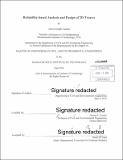Reliability-based analysis and design of 2D trusses
Author(s)
Ludeña, Alexis Joseph
DownloadFull printable version (7.932Mb)
Other Contributors
Massachusetts Institute of Technology. Department of Civil and Environmental Engineering.
Advisor
Jerome J. Connor.
Terms of use
Metadata
Show full item recordAbstract
Current safety factors used in structural design do not accurately account for uncertainties in material properties and required loads. These factors usually lead to overly designed structures but can also lead to under-designed structures because they are poor estimates of uncertainty. To correctly quantify the uncertainty in a structure we use reliability-based methods to analyze a 2D truss. This study first explores various types of methods used to calculate the reliability of an element to develop an automated analysis program. After finding the best methods needed for an accurate calculation of reliability, we define a set of random variables which affect the reliability of a structure. By developing a computationally automated framework to calculate the reliability of a 2D truss and its bar elements, we can gauge the efficiency and effectiveness of current design factors used. Additionally, we can also quantify the sensitivity of our analysis to its parameters to better understand the impact a single random variable can have in the overall calculation of reliability. Lastly, this reliability analysis framework can be used to conduct the reliability-based design of a steel bar member and a 2D truss system to optimize their probability of failure for various failure criteria.
Description
Thesis: M. Eng., Massachusetts Institute of Technology, Department of Civil and Environmental Engineering, 2014. Thesis: S.B., Massachusetts Institute of Technology, Department of Civil and Environmental Engineering, 2014. Cataloged from PDF version of thesis. Includes bibliographical references (page 61).
Date issued
2014Department
Massachusetts Institute of Technology. Department of Civil and Environmental EngineeringPublisher
Massachusetts Institute of Technology
Keywords
Civil and Environmental Engineering.